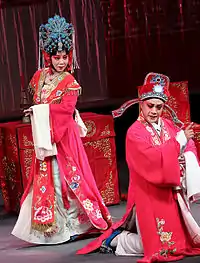Henan opera
Yu opera (simplified Chinese: 豫剧; traditional Chinese: 豫劇; pinyin: Yùjù), or Yuju opera, sometimes known as Henan bangzi[note 1] (Chinese: 河南梆子; pinyin: Hénán Bāngzi),[1] is one of China's famous national opera forms, alongside Peking opera, Yue opera, Huangmei opera and Pingju. Henan province is the origin of Yu opera.[2] Henan's one-character abbreviation is "豫" (yù), and thus the opera style was officially named "豫剧" (Yùjù) after the founding of the People's Republic of China. The area where Yu opera is most commonly performed is in the region surrounding the Yellow River and Huai River. According to statistical figures, Yu opera was the leading opera genre in terms of the number of performers and troupes.[3] While Yu opera is often called “Henan opera” in English, within Henan it is considered to be just one of the province’s three most important forms of opera (the other two are Quju 曲剧 and Yuediao 越调).

Outside Henan, provinces such as Hubei, Anhui, Jiangsu, Shandong, Hebei, Beijing, Shanxi, Shaanxi, Gansu, Qinghai, Xinjiang, all have professional Yu opera troupes. There is also a troupe in Kaohsiung, Taiwan. The history of Henan opera dated back to more than 200 years ago.[4] The opera was widely spread in Henan province in the late Qing Dynasty (1644-1911) and faced new development opportunities after the founding of PRC in 1949.[4] The opera spread across China and was ahead of the other 300 local operas in China before the mid-1980s.[4]
History
Yu opera into being during the late Ming and early Qing dynasties. At the beginning, it was mainly song arias without make-up, which was loved by the ordinary people. As a result, it developed rapidly. The origin of Yu opera was hard to trace, and the sayings about its origin were different.[5] With regard to the origin and formation of Henan opera, there was a shortage of records in ancient books and few scholars wanted to engage in in-depth and comprehensive exploration and research.[6]
Since the 1920s and 1930s there have been multiple theories and viewpoints on the origin of opera. There is no one theory that is generally agreed upon by researchers as there is not enough evidence to convince all people, so there are multiple similar and completely opposite arguments.[6] Four major representative opinions concerning the origin of the opera are presented following, they are originating from Shanxi opera, originating from the folk society of Henan, originating from the operatic tune which is popular in Central Plains area of China, and originating from the predecessor of Henan Bangzi.[6]
Tune types
There are four major types of Yu opera. Xiangfu tune opera is heard around Kaifeng; Yudong tune in the Shangqiu area. Yuxi tune is heard around Luoyang, and the Shahe tune around Luohe. Yudong and Yuxi are the main forms, with Yudong expressing comedy and Yuxi expressing tragedy. In the late Qing Dynasty(1644-1911), Henan Bangzi have been greatly expanded in Henan. Due to different living habits, language characteristics, natural environment, cultural psychology, and aesthetic tastes, Henan Bangzi has changed from the repertoire to operatic tune in different regions of Henan.[6] Therefore, four main tune types of Henan opera formed.[6] The four types are centered on different regions in Henan province.[6]
Famous people
The most famous Henan opera actors and actresses are Chang Xiangyu, Chen Suzhen, Cui Lantian, Ma JinFeng.[7] Besides the four actresses mentioned, there are also some well-known actors such as Zhao Yiting, Tang Xicheng, Li Sizhong.[4]
Zhao Yiting (1995-1992), a member of the Chinese Theatre Association and director of the Henan Theatre Association. His artistic career spans more than 60 years and has made outstanding contributions to the theatrical career. He is an important figure in the history of Henan opera.
Tang Xicheng (1924-1993), a member of the Chinese Theatre Association, director of the Henan Theatre Association. The achievements of his artistic achievements contributed to the highest peak of the male character in Henan opera and Mr. Tang is a master of Henan opera.
Li Sizhong (1921-1996), a famous master of the Henan opera, the representative of the Heilian performer ("male character with darkish painted face") of Henan Opera.
Status quo and suggested solutions
As an important local opera genre among the numerous non-material cultural heritage related Chinese operas, however, Henan opera are facing a hard situation on the protection and development.[8] As many other local operas, the future of Henan Opera is worrying due to the influence of commodity economy and the impact of modern lifestyles.[8] The number of plays and urban audience has reduced, and the rural audience is dominated by the elderly.[8] As for suggestions to improve the hard situation, Henan opera can establish a mutual benefit with tourism resource to appeal more audience.[8] At the same time, the exploration and research of Henan opera materials can be enriched, the investment in the development of Henan opera can be increased, and the productization of Henan Opera tourism meets the need of the times.[8] There are some specific strategies such as strengthening the tourism propaganda of Henan opera, building the characteristic brand of Henan opera culture, developing the Henan opera tourism experience project, holding the Henan opera festival, Cultivating the new force of Henan opera tourism, and exploring various development model of Henan opera tourism.[8]
Footnotes
- "Bangzi" meaning wooden clappers with bars of unequal length
References
- "Yu Opera". 中国广播网. 2010-12-01.
- "The Rebirth of Yuju Opera". CRI. August 21, 2002.
- "从数据看全国戏曲剧种的构成与分布". 中国文化部. 2006-04-20. Archived from the original on 2011-10-02. Retrieved 2011-07-06.
- "Yuju Opera". Chinese Opera. 27 February 2010. Retrieved 2 July 2019.
- "Art - Henan Opera". CRI. 2007-04-12.
- 陈, 国华 (2011). "豫剧发展流变探究". 吉林艺术学院学报 (02): 37–41. doi:10.13867/j.cnki.1674-5442.2011.02.012. ISSN 1674-5442.
- Chinadaily.com.cn (2003). "Henan Opera" (Web). Ministry of Culture of the People's Republic of China. Retrieved 2007-04-21.
- 陈, 国华; 潘, 薇 (2010). "河南省戏剧类非物质文化遗产旅游开发研究——以豫剧为例". 吉林艺术学院学报 (01): 33–36. doi:10.13867/j.cnki.1674-5442.2010.01.009. ISSN 1674-5442.